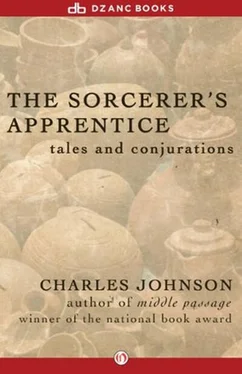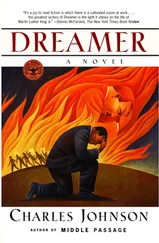Charles Johnson - Sorcerer's Apprentice
Здесь есть возможность читать онлайн «Charles Johnson - Sorcerer's Apprentice» весь текст электронной книги совершенно бесплатно (целиком полную версию без сокращений). В некоторых случаях можно слушать аудио, скачать через торрент в формате fb2 и присутствует краткое содержание. Год выпуска: 2014, Издательство: Dzanc Books, Жанр: Современная проза, на английском языке. Описание произведения, (предисловие) а так же отзывы посетителей доступны на портале библиотеки ЛибКат.
- Название:Sorcerer's Apprentice
- Автор:
- Издательство:Dzanc Books
- Жанр:
- Год:2014
- ISBN:нет данных
- Рейтинг книги:3 / 5. Голосов: 1
-
Избранное:Добавить в избранное
- Отзывы:
-
Ваша оценка:
- 60
- 1
- 2
- 3
- 4
- 5
Sorcerer's Apprentice: краткое содержание, описание и аннотация
Предлагаем к чтению аннотацию, описание, краткое содержание или предисловие (зависит от того, что написал сам автор книги «Sorcerer's Apprentice»). Если вы не нашли необходимую информацию о книге — напишите в комментариях, мы постараемся отыскать её.
Sorcerer's Apprentice — читать онлайн бесплатно полную книгу (весь текст) целиком
Ниже представлен текст книги, разбитый по страницам. Система сохранения места последней прочитанной страницы, позволяет с удобством читать онлайн бесплатно книгу «Sorcerer's Apprentice», без необходимости каждый раз заново искать на чём Вы остановились. Поставьте закладку, и сможете в любой момент перейти на страницу, на которой закончили чтение.
Интервал:
Закладка:
So my labor up frost-covered hills, alongside thick, unfenced woods, through cornfields bleached by snow gives Mildred and Gary a brief moment to practice “Fiir Elise,” and gives me four hours to myself, my black medical bag beside me — dear old satchel of tricks, tools, all Western methodology in a portmanteau, my pipe crackling softly, and steamy car window parted slightly so I don’t fall asleep. It is pleasant and quiet, out here on the road with the sky very blue, the wind cold, and the air clear. During these drives I pull hard on my pipe and ponder nothing as ordinary as my old woman’s odd ways, but instead scientific problems that have puzzled me most of my life — the ontogenesis of personality, for example, which is fully explained by the famous French neurobiologist Henri Ey in Études psychiatriques (Vol. III, 1954). There can be little doubt that personality is the product — no — the historical creation of society. The world and man, according to Ey, engender one another, but this implied — and here my thoughts shift as quickly as gears on my Buick — that, ultimately, the most intimate features of a man’s personality, those special aspects he believed individual and subjective and unique — kinks and quirks — had their origin, like Oxydol and doorknobs, in the public sphere, probably in pop culture. In other words, what we took to be essential in man throughout history might be accidental. A startling thesis, I’d have to say. But no more startling than the possibility that no man can escape the ceiling his culture sets for him, its special strengths and sicknesses. The case could be put in these terms: Certain aberrations in an Age might be so universal as to be unquestioned, and not recognized as problems for a thousand years. You’ll think this mad, and I did, too, driving ten miles an hour, heavy snow swirling down; but I had been in half the sickrooms of southern Illinois, seen patients as physically healthy as prizefighters suddenly founder, then fail, and for no material reason, far as I could see, as if, strange to say, the malady lay in the invisible realm of values and belief.
Being an old man, I know theories are as plentiful as blackberries, so I’d be the last person to take such a playful hypothesis for true. These thoughts, however, kept my mind occupied during the drive to Anna Montgomery’s. So occupied, in fact, that I was only faintly aware of the road sheering downhill, something streaking above the trees overhead, then static and a soft, miniature voice in my radio. The snow around me, it appeared, was melting. My foot shook on the accelerator. Then my engine got the hiccups, coughed, sputtered, and stopped cold. A shadow fell. Something blocked out the sun. The ground rumbled like eight-point-nine on the Richter scale, and I thought, Earthquake! They happen each spring in southern Illinois, but wasn’t this winter? Cranking the starter key, slamming the stick into reverse, I saw through the frosty windshield — in a shock that made me whimper and rub my sleeve against the glass — a tremendous ship, two pie plates stuck together, hurtling soundlessly toward me, low, burning the crisp November air black with radiation. It zigzagged back and forth, snapping off a colonnade of tall-shafted pines atop a hill, then toppled Wayman Presley’s fifty-foot cross (a local landmark of sorts) like a matchstick, made a hundred-degree turn without slowing down, then slogged into the earth. The explosion was stupendous, an earth-rocking blitz that ripped the roof off my car and threw me to one side of the road. Then all was quiet. For an instant I didn’t know what it was hit me. My carhood was oxidized. My radiator boiled over. Faintly, the ship’s relays and circuits clicked. Its surface burned first brick-red, then beryllium. And then something called to me from inside.
II.
You can well imagine the dread and despair this caused me. Flying saucers, I have read, were psychic phenomena, products of a troubled mind, particularly a mind broken by peering too long at the Abyss, but here before me in a field of brown slush, beneath a cindery sky, was a vessel the likes of which I’d never seen.(A complex ship powered by the synthesis of plutonium and 4Yb, an ytterbium isotope. No time to relate this now. You’ll find details elsewhere in this dossier.) That meant I was crazy. My mind had snapped — the result, I reasoned, of long hours at the hospital, too little sleep, talking cheerfully to patients only I knew would be dead before daybreak. What puzzled me was why lunacy had taken so long in coming. But crazy or not, I heard something squeal from inside. I was, as I say, still a physician. I picked up my bag, took two Pervitin, for I was still dazed, and forded weeds to the ship’s entrance — a sort of orifice that opened with a quick, vegetable contraction as I came near. It looked real. It felt real. Quite possibly, it was real. Cautiously, I climbed inside. Behind me the hole closed with a hiss, a sphincteral snap so suggestive of the lower regions, of entombment, caskets and crypts that for a moment I could not move. The wail grew louder. A shiver passed through my back. If my intuition was right, this ship was older than the world. The entrance blended into a maze of propellant tanks, hatches, cables, crawl spaces: a bathysphere, or so I thought at first. So far all right.
But slowly the familiar blended into foreign shapes as I patched on, pushing through walkways smaller than those in a Civil War submarine. The machinery I saw now (on the ceiling) favored glasswork sculpture, fantasmata that might please the aesthetic taste of tarantulas. And it didn’t sound like machinery — it might have been the echo of cell division I heard, the ring of enucleation, or embryo fission, the clack of hadrons collapsing into their constituent quarks. Little as I knew of space flight, I knew all technology was an extension of the body, but here interior design did not distinguish left (evil) or right (good), front or back, as if the pilot had no center, physical or metaphysical. What I felt was awe. What I felt, plainly, was terror. Almost I wanted to flee. Nothing even vaguely human would build a vessel like this. Now the wailing became a whimper. Then, abruptly, all was light. There came a cool splash of air, and I stood weaving in the lancet arch to a new chamber. I drew my neck in. My palms began to sweat, the way they perspired in the days when I first dated Mildred, for as a young man in medical school, the only Negro in my class — the one chosen to prove the Race’s worth — I so doubted myself it seemed miraculous that a woman as beautiful as Mildred, with her light voice and brilliant eyes, would have me. Success in middle age, even the citations on my office wall, had not shaken this feeling that I’d not fully comprehended my own (foster) culture, that George Twenhafel, who counted it as his heritage, understood something I did not. Why these thoughts arose as I groped deeper into the saucer, I cannot say. Its strangeness seemed to trigger in me the same primordial feeling of thrownness that every Negro experiences when hurled into a society that simultaneously supports and, I am saying, annihilates him, because he can find reflections of himself nowhere in it — like a falcon exiled, say, to the Lifeworld of fish, always off-balance, but finally embracing the alien in all its otherness, yet never sure if he’s got it right. (My ancestors — or so I’ve read — had a hundred concepts for the African community, but none for the “individual,” who, as we define him today — the lonely Leibnizean monad — is an invention of the Industrial Age, as romantic love is the product of medieval poets. My ancestors, I’ve also heard, were pre-Industrial and, therefore, are no test of reality. But enough.) Panting a little now, I stepped inside, pouring sweat….
Читать дальшеИнтервал:
Закладка:
Похожие книги на «Sorcerer's Apprentice»
Представляем Вашему вниманию похожие книги на «Sorcerer's Apprentice» списком для выбора. Мы отобрали схожую по названию и смыслу литературу в надежде предоставить читателям больше вариантов отыскать новые, интересные, ещё непрочитанные произведения.
Обсуждение, отзывы о книге «Sorcerer's Apprentice» и просто собственные мнения читателей. Оставьте ваши комментарии, напишите, что Вы думаете о произведении, его смысле или главных героях. Укажите что конкретно понравилось, а что нет, и почему Вы так считаете.












